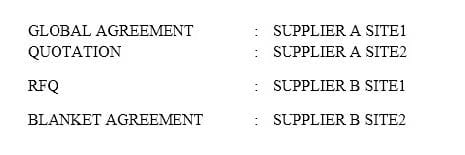Exam Details
Exam Code
:1Z0-520Exam Name
:Oracle E-Business Suite R12.1 Purchasing EssentialsCertification
:Oracle CertificationsVendor
:OracleTotal Questions
:285 Q&AsLast Updated
:Mar 27, 2025
Oracle Oracle Certifications 1Z0-520 Questions & Answers
-
Question 31:
You are the manufacturing lead for XYZ's implementation of Oracle E-Business Suite Release 12.
Your client has these requirements:
1.
Create a production plan.
2.
Analyze Sales Order information.
3.
Calculate capacity load ratio by resource or production line.
4.
Analyze resources, materials, costs, and job schedule progress.
Identify the two flows you would implement to accomplish these requirements. (Choose two.)
A. Click to Order
B. Order to Cash
C. Procure to Pay
D. Forecast to Plan
E. Demand to Build
-
Question 32:
Which sequence best represents the Procure to Pay life cycle flow?
A. Run compliance testing. > Enter suppliers. > Process returns.
B. Create purchase order. > Record manual payment. > File invoices.
C. Negotiate contracts. > Fulfill purchase order. > Generate supplier reports.
D. Enter invoice. > Match invoice to purchase order. > Return goods to suppliers.
E. Request for quote. > Analyze commodity. > Create payment outside payables.
-
Question 33:
The Requisition Open Interface is loaded from a variety of sources. Identify five. (Choose five.)
A. Oracle Inventory
B. Oracle Purchasing
C. Oracle iProcurement
D. Oracle Order Management
E. Internal Requisitions
F. Oracle WIP (Work in Process)
G. Flat files from non-Oracle systems
H. Oracle MRP (Material Requirements Planning)
-
Question 34:
The Child Lots check box is enabled at the organization item level. Which two statements are true? (Choose two.)
A. The lot splitting process is enabled by this feature.
B. The system would maintain lot genealogy with child and parent lots.
C. Child lot characteristics are completely different from that of parent lots.
D. Child lots are unique and independent lots. They are not linked with parent lots.
E. Short expiry lots are child lots. Child lots generate unique numbers across items.
F. Child lots are a subdivision of the parent lots and maintain integrity with the parent lots.
-
Question 35:
You import requisitions from another system. These requisitions are imported as approved requisitions and contain references to items in the item master and blanket purchase agreements.
What is the easiest way to automatically create orders from these requisitions?
A. Using the AutoCreate form.
B. Running the Create Releases program.
C. Running the Workflow Background Processor.
D. Running the Purchasing Documents Open Interface.
-
Question 36:
Which three statements regarding inventory forecasting are true? (Choose three.)
A. Focus forecasting can only be generated from historical data.
B. Focus forecasting is typically used to produce single period forecasts.
C. Statistical forecasting can be generated from either historical data or master schedule entries.
D. Statistical forecasting enables you to apply exponentially weighted trend and seasonality factors to predict demand.
E. Statistical forecasting enables you to simulate various methods of calculating demand so that you can select the best forecasting model.
-
Question 37:
The Quotation lifecycle contains three statuses, In Process, Active, and Closed.
When would you choose the Active status?
A. When you create the quotation.
B. When you approve the supplier's quote.
C. When the quote is received and approved.
D. When the supplier quote is received and entered.
E. When the quotation is complete and ready to be approved.
F. When you receive the quote within the quote's Effectivity Dates.
-
Question 38:
The purchasing manager of ABC Corp., needs to procure aluminum sheets. The purchasing manager wants to default supplier, site, and source document information on the requisition. The purchasing manager creates an approved supplier list and sourcing rule, but does not associate any source document in the approved supplier list. A global agreement, a quotation, a request for quotation (RFQ) and blanket agreement exist for this item.
The purchasing manager sets the "PO: Automatic Document Sourcing" to Yes.
The supplier and supplier site information are as follows:

Which supplier and supplier site would default on the requisition?
A. SUPPLIER B, SITE2
B. SUPPLIER A, SITE2
C. SUPPLIER A, SITE1
D. SUPPLIER B, SITE1
E. No supplier or site information would be populated.
-
Question 39:
Which key area in the Procure to Pay process involves using Oracle iExpenses to enter expense reports via a Web browser?
A. Payment
B. Invoicing
C. Sourcing
D. Reporting
E. Receiving
-
Question 40:
The functional currency of Company X is USD. Company X placed a purchase order on supplier Y on 01SEP-2007, for one unit of item A at a unit price of Euro 80. According to the exchange rate on 01-SEP2007, Euro 80 = USD 100.
Goods are received on 05-OCT-2007. Due to exchange rate changes, at this time Euro 80 is now
equivalent to USD 105.
The standard cost of the item is USD 75.
Freight charge = USD 10.
Handing charge = USD 5.
The Purchase Price variance for this transaction is_________.
A. USD 25
B. USD 30
C. USD 35
D. USD 40
E. USD 45
F. USD 50
Related Exams:
1Z0-020
Oracle8i: New Features for Administrators1Z0-023
Architecture and Administration1Z0-024
Performance Tuning1Z0-025
Backup and Recovery1Z0-026
Network Administration1Z0-034
Upgrade Oracle9i/10g OCA to Oracle Database OCP1Z0-036
Managing Oracle9i on Linux1Z0-041
Oracle Database 10g: DBA Assessment1Z0-052
Oracle Database 11g: Administration Workshop I1Z0-053
Oracle Database 11g: Administration II
Tips on How to Prepare for the Exams
Nowadays, the certification exams become more and more important and required by more and more enterprises when applying for a job. But how to prepare for the exam effectively? How to prepare for the exam in a short time with less efforts? How to get a ideal result and how to find the most reliable resources? Here on Vcedump.com, you will find all the answers. Vcedump.com provide not only Oracle exam questions, answers and explanations but also complete assistance on your exam preparation and certification application. If you are confused on your 1Z0-520 exam preparations and Oracle certification application, do not hesitate to visit our Vcedump.com to find your solutions here.